Understanding Antibodies: Structure and Function
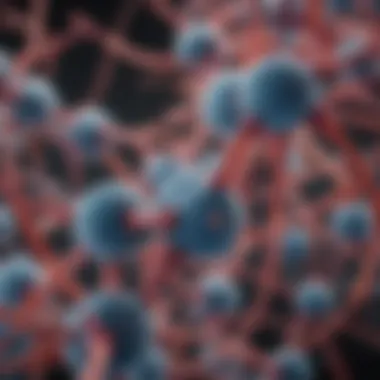
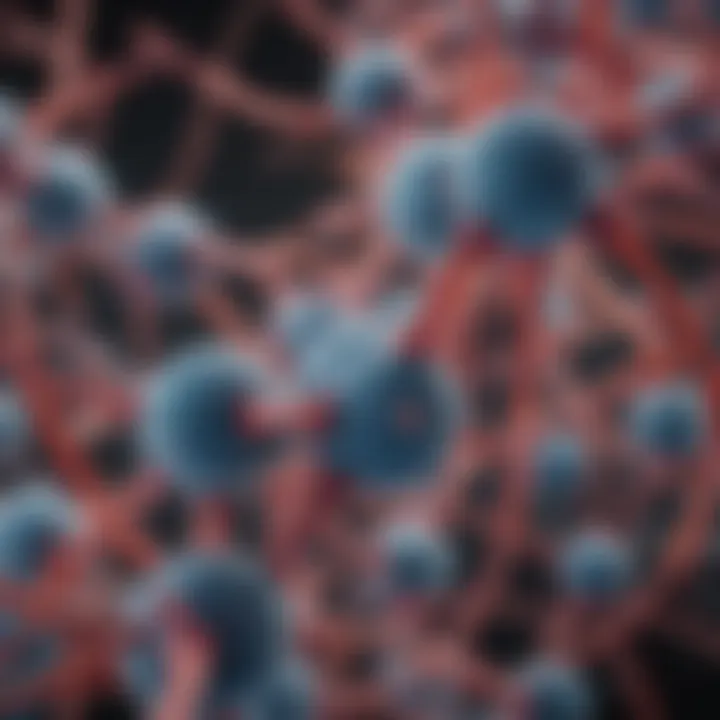
Intro
Antibodies, also referred to as immunoglobulins, play a pivotal role in our immune defense. These specialized proteins are produced in response to pathogens, such as viruses and bacteria, and are essential for identifying and destroying these foreign invaders. Understanding their structure and function is crucial not only for students and researchers but also for healthcare professionals seeking to navigate the increasingly complex landscape of immunology.
As we peel back the layers of their composition, we uncover not just their building blocks, but also the remarkable mechanisms through which they operate. By grasping how antibodies respond to various pathogens and distinguish between self and non-self, we gain valuable insights into disease management and therapeutic interventions.
Research Highlights
Overview of Key Findings
Antibodies are classified into five main classes: IgA, IgD, IgE, IgG, and IgM. Each class has its distinct structure and function, tailored to combat specific pathogens. For example, IgG is the most abundant antibody in circulation and is primarily responsible for long-term immunity, while IgE is tied to allergic reactions and defense against parasites.
Significantly, the composition of antibodies involves amino acids arranged in a unique fashion, enabling them to bind effectively to specific antigens. This specificity is the crux of their function, making antibodies a critical tool in both innate and adaptive immunity.
Significance of the Research
Understanding the intricate workings of antibodies can drastically transform the approach to vaccine development and autoimmune disease treatment. With advancements in biotechnology, such as monoclonal antibody therapy, the potential to devise targeted treatments has grown immensely. Consequently, delving into antibody research not only contributes to basic science but also holds explorative potential for future therapeutic breakthroughs.
Original Research Articles
Summary of the Article
In this piece, the structural components of antibodies were examined thoroughly, illuminating how their design reflects their function. The unique domains of antibodies help delineate their interaction with antigens, ultimately leading to a variety of immune responses. Furthermore, the effects of mutations in amino acids, whether natural or induced, illustrate the delicate balance that regulates antibody efficacy.
Author Contributions
The authors have contributed meaningfully by dissecting the molecular composition of antibodies. Their insights into how different amino acids impact the binding capacity of antibodies shed light on optimizing their utility in clinical settings. Additionally, ongoing research from multiple sources has been acknowledged to provide a comprehensive backdrop against which the findings can be appreciated.
"Antibodies are the frontline soldiers that guard our bodies against invaders; understanding their structure and function arms us with the knowledge to protect our health better."
In summary, the exploration of antibodies is not just academic; it is fundamentally tied to our understanding of health and disease. The interplay between their structure, classification, and function provides a robust framework for future research endeavors. Anyone aiming to traverse the intricate landscape of immunology will find value in grasping the significance of these remarkable proteins.
Foreword to Antibodies
Antibodies, or immunoglobulins, are the linchpins of the immune system's defense mechanisms. They perform some critical roles, primarily by recognizing and neutralizing pathogens that invade the body. Understanding antibodies is paramount, as they represent a sophisticated system that not only fights infections but also plays an essential part in diagnostic and therapeutic arenas.
By diving into the structure and function of antibodies, we gain insights into how our bodies distinguish friend from foe at the molecular level. Moreover, exploring this topic leads to a greater appreciation of the therapeutic applications, as monoclonal antibodies are being utilized in treatments ranging from cancer to autoimmune diseases.
Definition and Role
An antibody is a Y-shaped protein produced by B cells. Its primary role is to bind to specific antigens—foreign substances such as bacteria and viruses. Once bonded, antibodies neutralize toxins, initiate the destruction of pathogens, or mark them for elimination by other components of the immune system. The affinity and specificity of an antibody’s binding are what make it a very powerful soldier in the immune response arsenal.
To elaborate, antibodies can perform several functions, such as:
- Neutralization: They can directly neutralize viruses or toxins by binding to them.
- Opsonization: This process marks pathogens for destruction by other immune cells.
- Complement Activation: Antibodies can trigger a cascade reaction that leads to the lysis of the pathogen.
- Antibody-Dependent Cellular Cytotoxicity (ADCC): They mediate the destruction of infected cells through the recruitment of natural killer (NK) cells.
Historical Context
The history of antibodies goes back to the late 19th century. Pioneers like Emil von Behring and Shibasaburo Kitasato were the first to identify the importance of serum components in fighting infections, paving the way for our understanding of immunity. Their groundbreaking work led to the concept of serotherapy, which utilized antibodies to treat diseases like diphtheria.
In the following decades, the discovery of immunoglobulin classes by researchers such as Paul Ehrlich helped elucidate the vast complexity of this immune response. Fast forward to the 1970s, when scientists Frederick Sanger and others pioneered techniques for antibody production, leading to the creation of monoclonal antibodies—these highly specific tools have since revolutionized diagnostics and therapeutics.
In sum, the journey of understanding antibodies has evolved dramatically, from sporadic serotherapy to advanced biotechnological applications that address diverse medical challenges. This historical standpoint emphasizes the critical role antibodies play not just in our immune system but also in the broader context of medical innovation.
Basic Structures of Antibodies
Understanding the basic structures of antibodies is essential for grasping their complex roles within the immune system. These structures not only dictate how antibodies function but also shape their interaction with various pathogens, offering insights into both health and disease management. The composition of antibodies, from their individual amino acids to their larger polypeptide chains, plays a pivotal role in defining how effectively they can recognize and neutralize foreign invaders.
Amino Acid Composition
At the heart of every antibody lies its amino acid composition, which forms the backbone of the protein structure. Antibodies are primarily made up of twenty different amino acids, each contributing to the three-dimensional shape that is crucial for functionality. These amino acids can be categorized into two groups: polar and nonpolar. Polar amino acids tend to be hydrophilic and are often located on the surface of the antibody, facilitating interactions with water and other molecules. Nonpolar amino acids, on the other hand, are typically buried within the structure, providing stability to the overall conformation.
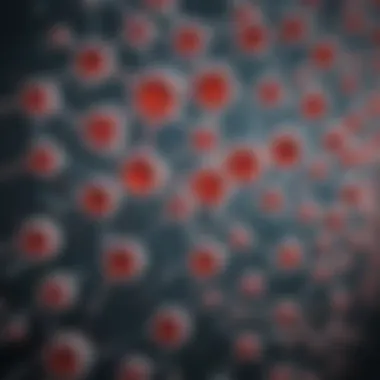
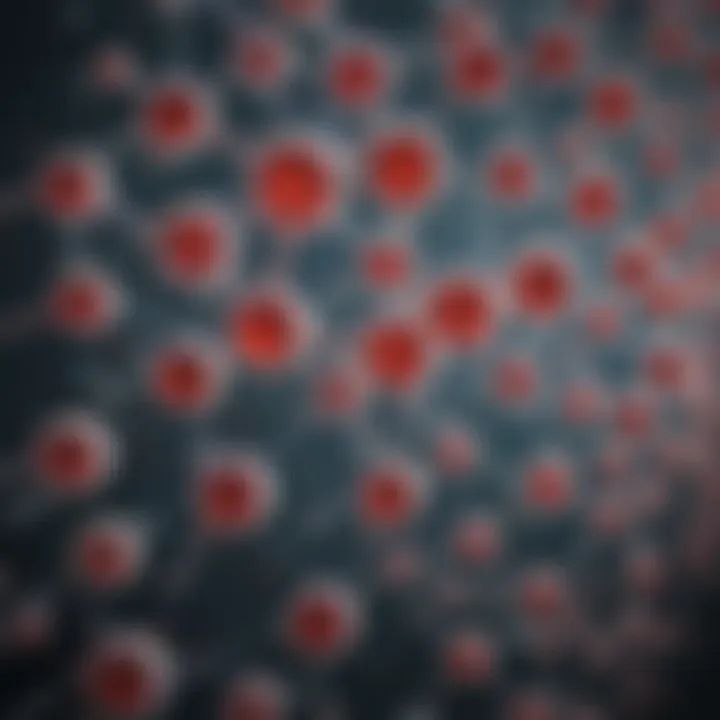
This composition isn’t just about structure; it's about specificity as well. The sequence and arrangement of amino acids in the variable region of antibodies determine their unique antigen-binding sites. For example, small changes in amino acid sequences can lead to significant alterations in how an antibody interacts with a particular pathogen, such as a virus or bacterium.
Polypeptide Chains
Antibodies are made up of polypeptide chains, generally composed of four chains: two heavy chains and two light chains. These chains are crucial in determining the overall architecture of the antibody. The heavy chains are responsible for most of the antibody's biological function, whereas the light chains primarily serve as facilitators for antigen recognition. Each of these chains is linked together by disulfide bonds, creating a stable structure that can withstand various physiological conditions.
The arrangement of these chains allows antibodies to adopt a Y-shaped configuration, which is vital for binding to antigens effectively. This structure provides a wide array of binding sites, enhancing the ability of antibodies to engage various pathogens during immune responses.
Variable and Constant Regions
One of the distinguishing features of antibodies is the existence of variable and constant regions. The variable regions are responsible for the unique binding characteristics of each antibody, allowing for the recognition of a diverse range of antigens. This variability is achieved through somatic hypermutation, a process where the DNA sequences encoding these regions mutate at a significantly higher rate during B cell activation. This means that when an antigen is encountered, the immune system can rapidly generate antibodies that fit the specific shape and structure of the invader.
In contrast, the constant regions of antibodies serve a more uniform purpose. These regions determine the antibody's class and dictate how it interacts with other components of the immune system, such as binding to receptors on immune cells.
The ability of antibodies to vary in their binding sites while maintaining a stable functional structure highlights the intricacy of the immune response.
Understanding these structural elements provides a foundation for appreciating how antibodies are tailored to recognize and combat different pathogens, thereby protecting the body from a myriad of diseases. This knowledge is crucial not only for students and researchers but also for healthcare professionals engaged in the development of therapies against infections and diseases.
Types of Antibodies
Understanding the different types of antibodies is essential in recognizing how our immune system functions. Each type has its specific role, interacting with pathogens in distinct ways. This subdivision of immunoglobulins not only underlines the diversity of functions but also highlights their importance in both health and disease. Clinically, knowing the type of antibody involved can guide effective treatment strategies and diagnostics.
IgG: The Most Abundant Antibody
IgG is the heavyweight champion of the antibody world. It accounts for about 75% of the antibody in serum. One primary role of IgG is to provide long-term protection against pathogens. When the body first encounters a new threat, it produces IgM, but IgG kicks into gear later, thanks to memory B cells.
IgG antibodies are particularly good at crossing placenta, providing passive immunity to newborns. This feature underscores their importance in maternal health. Furthermore, IgG can neutralize toxins, activate the complement system, and enhance phagocytosis—quite a hefty resume.
IgM: The First Responder
IgM is the body's initial line of defense during an infection. It's the first antibody produced in response to an infectious agent, making it crucial for early immune responses. Structurally, IgM exists as a pentamer, which allows it to bind to multiple antigens effectively.
Just like the first responders in an emergency, IgM acts fast, but it doesn’t last long. After a few weeks, levels decrease as IgG takes over. Its quick action can be lifesaving, yet it also indicates a recent infection when detected in blood tests.
IgA: The Mucosal Protector
IgA plays an essential role at mucosal surfaces—think of it as the guardian of your cavities, like the gut and respiratory tract. Found in saliva, tears, and breast milk, IgA is pivotal for mucosal immunity. What sets IgA apart is its ability to be secreted out of the body, effectively trapping pathogens before they establish an infection.
This type of antibody protects the body from many pathogens that come into contact through mucosal surfaces. Its presence in breast milk also nourishes and offers protection to newborns, establishing their immune system from a very early stage.
IgE: The Allergy Mediator
IgE might be the least known of the antibody classes, but it plays an outsized role in allergic reactions. It’s a bit of a troublemaker, as its primary function is to bind to allergens and trigger histamine release from mast cells. This is the mechanism behind common allergies—think peanuts, pollen, or pet dander.
In small amounts, IgE serves as a protective mechanism against parasitic infections. However, when the immune system misfires, it leads to an overreaction, resulting in allergies or even dangerous anaphylaxis. This duality makes IgE a particularly fascinating antibody.
IgD: The Unknown Function
IgD is somewhat of an enigma in the world of antibodies. While it's present in small amounts in serum and predominantly found on the surface of immature B cells, its exact role remains largely undefined. Researchers postulate that it aids in the initiation of B cell activation and differentiation. Yet, its mystery endures, as the complexities of its function continue to be explored.
"Although it represents a tiny fraction of total serum antibodies, IgD challenges our understanding of immunology, inviting curiosity and rigorous study."
Mechanisms of Antibody Action
Antibodies play a fundamental role in the immune response, acting like the body’s specialized soldiers against invading pathogens. Their mechanisms of action are critical for neutralizing threats and preventing disease. Understanding these actions not only underscores the elegance of the immune system but also provides insights into therapeutic approaches and vaccine development. The three primary mechanisms—neutralization of pathogens, opsonization, and antibody-dependent cell-mediated cytotoxicity—demonstrate how antibodies can eliminate invaders and fortify the body’s defenses.
Neutralization of Pathogens
When antibodies encounter pathogens such as viruses and bacteria, they can bind to these organisms, effectively neutralizing them. This binding prevents pathogens from entering and infecting host cells. Think of it like blocking a doorway—once the antibody occupies the space, the invader cannot proceed.
Key Points:
- Prevention of Infections: Neutralization stops pathogens from attaching to cells, halting their infectious ability.
- Blocking Toxins: Some antibodies can neutralize toxins released by bacteria. An example is the botulinum toxin, where antibodies bind to the toxin and prevent its harmful effects.
- High Specificity: Each antibody targets a specific pathogen through its unique binding site, known as the antigen-binding site, which ensures that the response is precise rather than broad.
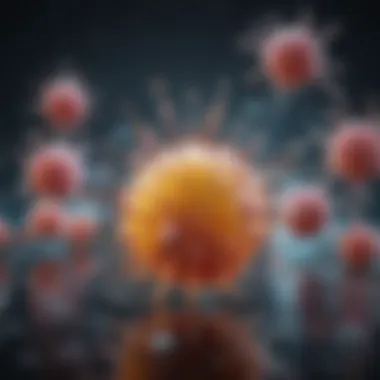
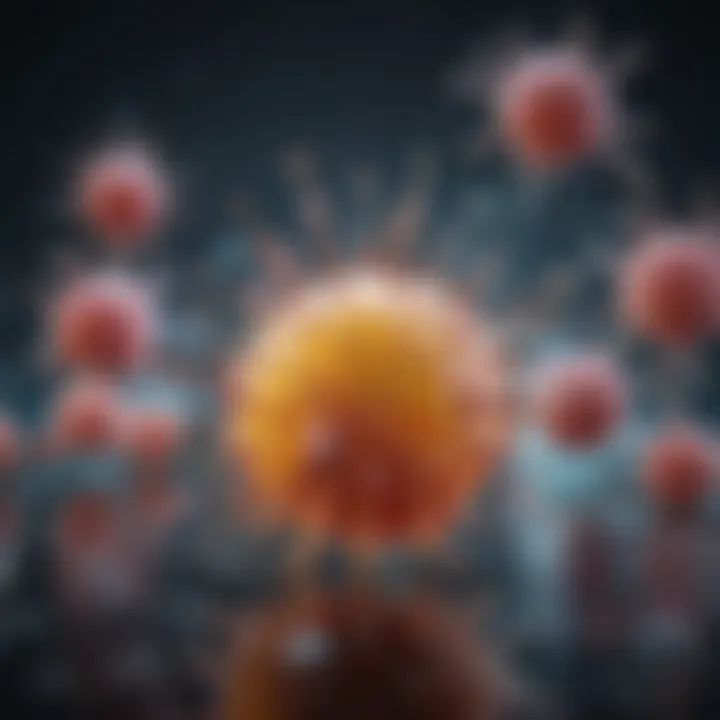
"The specificity of antibodies is like having a key that only unlocks one specific lock."
This precise targeting increases the efficacy of our immune response and helps in developing antibodies for therapeutic purposes.
Opsonization: Marking Invaders
Opsonization works hand-in-hand with neutralization but shifts focus. In this process, antibodies coat pathogens, making them easier targets for immune cells. This is akin to tagging a parcel for delivery; it allows the immune system to recognize invaders more efficiently. By binding to the surface of pathogens, antibodies enhance their visibility to phagocytes such as macrophages and neutrophils, which then engulf and destroy the coated invaders.
Benefits of Opsonization:
- Enhanced Phagocytosis: The presence of antibodies on the pathogen surface increases the likelihood of phagocytosis, allowing for faster clearance.
- Complement Activation: Opsonized invaders can also activate the complement system, a series of proteins that assist in eliminating pathogens by perforating their membranes or tagging them for destruction.
This mechanism highlights the collaborative nature of the immune system, integrating various components to mount an effective response against infection.
Antibody-Dependent Cell-Mediated Cytotoxicity
Antibody-dependent cell-mediated cytotoxicity (ADCC) is another crucial mechanism. In this process, antibodies bind to target cells, such as infected or cancerous cells, signaling immune cells like natural killer (NK) cells to initiate destruction. Here, antibodies act as a bridge, linking the target cell with the NK cell, which unleashes cytotoxic granules that induce cell death.
Considerations Regarding ADCC:
- Efficiency Against Infected Cells: This method is particularly effective against cells harboring intracellular pathogens, as well as neoplastic cells.
- Therapeutic Applications: ADCC is a primary mechanism of action for certain monoclonal antibodies used in cancer treatment, offering a targeted approach to eliminate malignant cells.
ADCC demonstrates the complexity and adaptability of the immune response, showcasing the importance of both antibodies and innate immune cells in combating disease.
To wrap it up, the mechanisms by which antibodies act—neutralization, opsonization, and ADCC—reveal their indispensable role in the immune system. These processes allow the body to work collectively against pathogens, ultimately serving to protect health and maintain homeostasis.
Antibody Production
Antibody production is a vital part of the immune system's response to pathogens. Understanding this process not only sheds light on how our bodies defend themselves against infections but also informs advancements in medical treatments and vaccines. The functioning of antibodies is synonymous with their production, which occurs primarily through specialized cells known as B cells. These elements work tirelessly to ensure the body is kept safe from foreign invaders.
B Cells and Plasma Cells
The journey begins with B cells, a type of lymphocyte formed in the bone marrow. When an infection strikes, B cells become activated, moving swiftly to confront the threat. It's their ability to recognize specific antigens—distinctive markers on the surfaces of pathogens—that sets the stage for antibody production. Here’s how it works:
- Activation: When a B cell's receptor binds to an antigen, it triggers a chain reaction, calling other immune components into action.
- Differentiation: Some activated B cells become plasma cells. These cells are essentially antibody factories, churning out large quantities of antibodies tailored to the unique antigens they encountered.
- Antibody Secretion: Plasma cells release antibodies into the bloodstream, which disseminate throughout the body to bind pathogens, facilitating their neutralization or destruction.
Notably, memory B cells form during this process. These cells linger long after the infection has cleared, ready to mount a quick response if the same pathogen attempts to invade again.
Clonal Selection and Expansion
Clonal selection is a fascinating process that underpins antibody production. The premise is simple yet profound: B cells are genetically programmed with unique receptors. When a specific antigen enters the body, B cells with matching receptors proliferate, creating a clone of cells that are all geared to combat the same intruder. Here’s what happens:
- Selection: Only the B cells with receptors that fit the invader’s antigens are selected for expansion. This dramatic decrease in competition allows the immune system to hone in on the most effective responses.
- Expansion: Once selected, the B cells divide rapidly, increasing their numbers significantly. This expansion phase is crucial, as it enables a robust response against the pathogen, improving the chances of overcoming it.
- Affinity Maturation: Over time, B cells undergo a fine-tuning process, enhancing their receptors’ affinity for the antigen. This leads to the production of more effective antibodies tailored for the specific pathogen.
"The immune system is a natural marvel, efficiently orchestrating responses against disease while adapting to new challenges."
It's through the interplay between B cells, plasma cells, and clonal selection that the body mounts a formidable defense. As students and professionals explore the implications of these processes, they can appreciate the sophistication of the immune response, paving the way for innovations in treatments that can further enhance our ability to fight infections.
Factors Influencing Antibody Function
Antibodies are not produced in a vacuum; their functionality and effectiveness can be influenced by numerous factors. Understanding these elements is critical for both researchers and medical professionals, as they can have significant implications for treatment outcomes and immune response. This section will explore three main factors: genetic variability, environmental factors, and interactions with other immune cells. Each of these factors plays a vital role in shaping how antibodies respond to pathogens and maintain the body’s defense system.
Genetic Variability
Genetic variability in the immune system is a curious beast, often seen as a double-edged sword. On one hand, it enhances the diversity of antibodies produced, allowing the immune system to adapt to an ever-changing world of pathogens. On the other hand, excessive variability can lead to complications, such as autoimmune diseases, where antibodies mistakenly target the body’s own cells.
The immunoglobulin genes are organized in a unique way that allows for numerous combinations during B cell development, producing a wide array of antibodies specific to various antigens. This process is known as somatic hypermutation. Consequently, individuals with broader genetic diversity tend to have a richer repertoire of antibodies, leading to better immune responses.
However, this variability also creates challenges. Certain genetic backgrounds may predispose individuals to produce less effective antibodies. This situation highlights the importance of studying genetic factors when assessing an individual's immune response, especially in the context of vaccine efficacy or susceptibility to infections.
Environmental Factors
Environmental factors can significantly shape antibody function, often in ways we don’t fully appreciate. For instance, exposure to different pathogens, nutritional status, and even lifestyle choices can determine how well antibodies perform their duties.

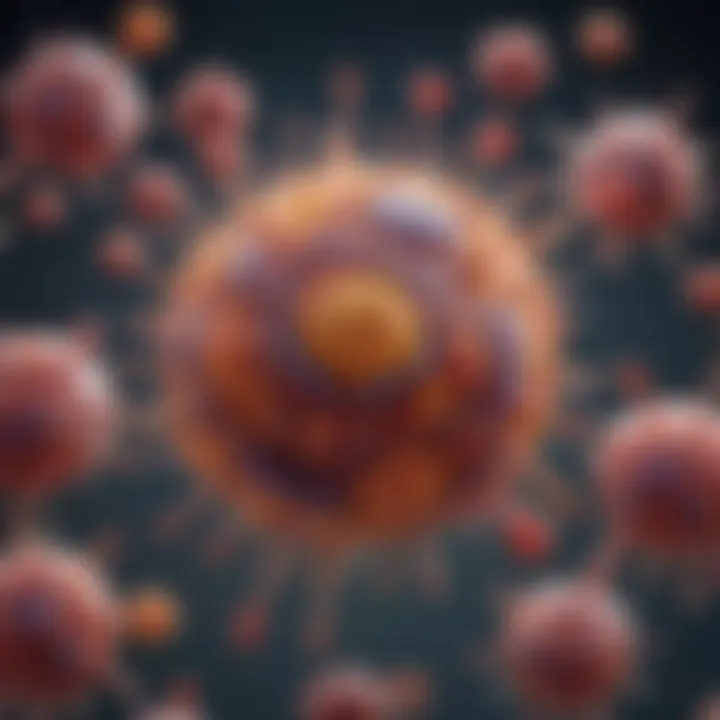
Key environmental influences include:
- Nutrient Availability: A diet rich in vitamins and minerals is crucial for optimal immune function. Deficiencies in key nutrients, such as vitamin D and zinc, have been linked to weakened antibody responses.
- Pathogen Exposure: The exposure history of pathogens can train the immune system. Previous infections can enhance the production of specific antibodies during future encounters with the same pathogens.
- Chemical Exposures: Certain chemicals and toxins in the environment can alter immune responses, sometimes leading to unexpected antibody production behaviors.
These factors underline the complex interplay between our environment and immune defenses. Understanding this relationship is vital, particularly in public health and immunology, as it could pave the way for tailored vaccination strategies.
Interactions with Other Immune Cells
Antibodies do not act alone; their functionality is greatly influenced by interactions with other immune cells. This collaboration can enhance or inhibit the total immune response, impacting how effectively antibodies can perform their role.
Significant interactions include:
- T Cells: Helper T cells provide crucial signals that activate B cells, prompting them to produce antibodies. If this interaction is compromised, antibody production may drastically decrease.
- Macrophages: These cells can enhance opsonization, a process where antibodies tag pathogens for destruction. Macrophages recognize and process these antibody-coated invaders, playing a crucial role in antibody efficacy.
- Regulatory T Cells: These cells help regulate immune responses and can dampen antibody production under certain conditions, preventing excessive inflammation but possibly hindering necessary immune responses.
"The immune system resembles a well-orchestrated symphony, where each player must perform their part at the right time for the whole ensemble to produce harmony."
Ultimately, the intricate dance between antibodies and other immune cells is fundamental for a coordinated defense against infections. So, understanding these interactions is crucial for developing immunotherapies and vaccines.
Applications of Antibodies
The practical applications of antibodies extend well beyond their immunological roles, marking their significance in both therapeutic and diagnostic realms. Antibodies have become indispensable tools in modern medicine, offering a slew of advantages when it comes to combating diseases and understanding biological processes. This section delves into the vital usage of antibodies, particularly emphasizing their therapeutic implications and their critical role in diagnostics.
Therapeutic Use in Medicine
Antibodies, especially monoclonal antibodies, revolutionize treatment protocols for various diseases, notably cancers, autoimmune disorders, and infectious diseases. Unlike traditional pharmaceutical products, antibodies possess a unique capacity to specifically target molecules or cells of interest, tackling disease at its root.
- Cancer Treatment: Monoclonal antibodies such as Rituximab and Trastuzumab have been pivotal in treating specific types of cancers. Their ability to block growth signals and flag malignant cells for destruction by the immune system serves as an innovative approach in oncology.
- Autoimmune Conditions: Medications such as Adalimumab target inflammatory pathways, providing relief for conditions like rheumatoid arthritis and Crohn's disease. These treatments often lead to a significant improvement in the quality of life.
- Infectious Diseases: The recent developments surrounding COVID-19 highlight antibodies' role in therapeutic interventions. Convalescent plasma therapies and monoclonal antibodies have been harnessed to enhance recovery from infections, exhibiting their potential as life-saving treatments.
Antibodies also present a range of benefits that contribute to their effective use in clinical settings:
- Highly Specific: They can precisely target specific antigens, minimizing harm to healthy cells.
- Long-Lasting Effects: Many therapies can provide prolonged impacts, allowing for fewer administrations over time.
- Customizable: Techniques like genetic engineering enable the design of antibodies that specifically meet therapeutic needs.
However, employing antibodies in treatment comes with considerations such as potential side effects, the need for careful patient monitoring, and high production costs. Despite these challenges, the strengths of antibody therapies cannot be overstated, as they offer tailored interventions that traditional methods often lack.
Diagnostic Tools
The role of antibodies extends significantly into the diagnostic landscape, offering crucial insights into disease detection and management. Various diagnostic tests utilize antibodies to identify pathogens, measure biological markers, and even monitor immune responses.
- ELISA (Enzyme-Linked Immunosorbent Assay): This widely used test employs antibodies to detect specific proteins in blood or other fluids. It's instrumental in diagnosing diseases ranging from infections to allergies.
- Western Blot: A technique that uses antibodies to detect specific proteins in a sample. Often used as a confirmatory test for HIV, its precision plays a key role in ensuring accurate diagnoses.
- Immunohistochemistry: This method employs antibodies to visualize specific antigens in tissue sections. It is widely applied in pathology for cancer diagnosis, giving pathologists valuable information regarding tumor characteristics.
Antibodies in diagnostics present several crucial advantages:
- Sensitivity and Specificity: Their ability to bind to specific targets allows for precise detection, reducing false positives.
- Rapid Results: Many tests can provide quick results, essential for timely medical interventions.
- Versatile Applications: From laboratory testing to point-of-care diagnostics, antibodies serve diverse roles across numerous disease contexts.
However, one must also acknowledge the limitations in diagnostics. Interference from other substances, variability in test results, and the need for trained personnel can pose challenges. Nevertheless, the integration of antibodies into diagnostic tools has transformed the way medicine addresses disease when coupled with other methodologies.
The evolution of antibody-based applications has not only saved countless lives but also reshaped the landscape of medical treatments and diagnostics in ways that were once unfathomable.
In summary, the applications of antibodies unfold a landscape where the promise of personalized medicine can finally be realized, marrying the intricacies of immunology with the practical needs of healthcare.
The End and Future Perspectives
The importance of concluding on this note extends beyond just a summary; it's about embracing the evolving landscape of antibody research. This section will shed light on current research trends and potential future developments that promise to reshape the field.
Current Research Trends
One current research trend focuses on monoclonal antibodies, which are increasingly being harnessed for therapeutic applications. Scientists are investigating their role in targeting specific diseases, especially in conditions like cancer and autoimmune disorders. The precision of monoclonal antibodies allows for more tailored treatments, minimizing collateral damage to healthy cells.
Additionally, biotechnological advancements have led to the engineering of bispecific antibodies, which can engage two different targets simultaneously. This promising approach has opened new pathways for combating diseases that require multifaceted strategies.
Some trending areas in antibody research also encompass the use of antibodies in vaccine development. With recent global health crises, the role of antibodies in providing immunity against novel pathogens has garnered immense focus. Vaccination strategies using recombinant antibodies offer the possibility of achieving fast immunological responses.
Potential Developments in Immunology
Looking ahead, the potential developments in immunology concerning antibodies are nothing short of fascinating. One of the most exciting possibilities is the integration of artificial intelligence in predicting antibody interactions and optimizing their designs based on genetic data. The synergy of AI with traditional immunological research can streamline the process of discovering and designing new antibodies, moving us closer to personalized medicine.
Moreover, advancements in gene editing technologies, such as CRISPR, offer a tantalizing glimpse into the future where tailored antibody therapies could be created at unprecedented speeds. The potential of such technologies might allow researchers to edit B cell genes directly, enhancing the responsiveness and adaptability of the immune system.
As we observe these emerging trends and potential breakthroughs, it's paramount to consider the ethical implications and need for responsible stewardship in antibody research. Striking a balance between innovation and ethical practice will be key to harnessing the full potential of antibodies in medicine and beyond.







